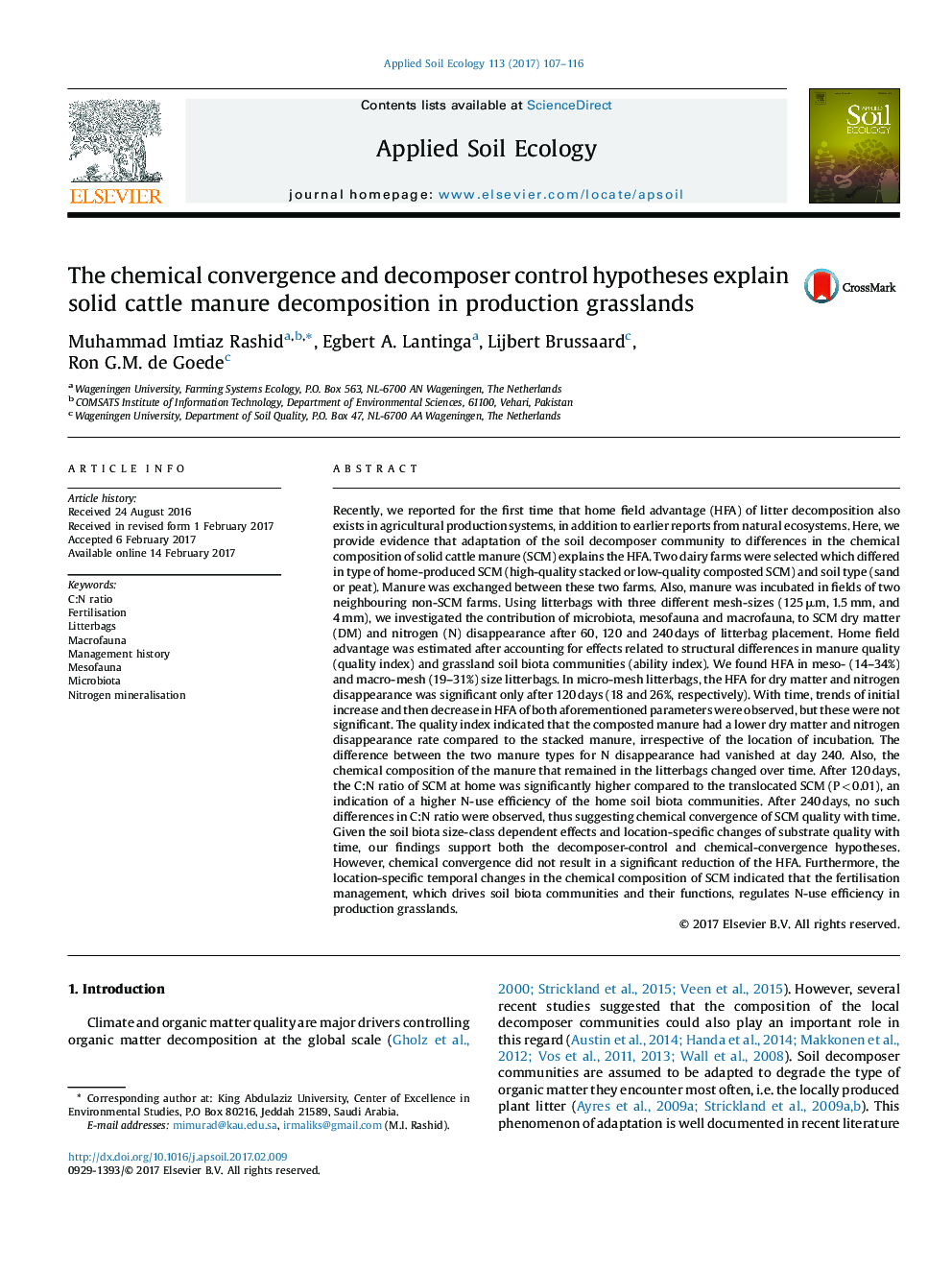| کد مقاله | کد نشریه | سال انتشار | مقاله انگلیسی | نسخه تمام متن |
|---|---|---|---|---|
| 5742741 | 1617770 | 2017 | 10 صفحه PDF | دانلود رایگان |
- Home field advantage (HFA) mechanism of solid cattlemanure (SCM) decomposition was studied.
- SCM in different mesh litterbags was exchanged between farms for up to 240Â days.
- Mesofauna strongly contributed to manure decomposition HFA throughout experiment.
- Microbiota did not contribute significantly to the HFA, except at day 120.
- With time, SCM decomposition HFA did not decline but C:N ratio of SCM's converged.
Recently, we reported for the first time that home field advantage (HFA) of litter decomposition also exists in agricultural production systems, in addition to earlier reports from natural ecosystems. Here, we provide evidence that adaptation of the soil decomposer community to differences in the chemical composition of solid cattle manure (SCM) explains the HFA. Two dairy farms were selected which differed in type of home-produced SCM (high-quality stacked or low-quality composted SCM) and soil type (sand or peat). Manure was exchanged between these two farms. Also, manure was incubated in fields of two neighbouring non-SCM farms. Using litterbags with three different mesh-sizes (125 μm, 1.5 mm, and 4 mm), we investigated the contribution of microbiota, mesofauna and macrofauna, to SCM dry matter (DM) and nitrogen (N) disappearance after 60, 120 and 240 days of litterbag placement. Home field advantage was estimated after accounting for effects related to structural differences in manure quality (quality index) and grassland soil biota communities (ability index). We found HFA in meso- (14-34%) and macro-mesh (19-31%) size litterbags. In micro-mesh litterbags, the HFA for dry matter and nitrogen disappearance was significant only after 120 days (18 and 26%, respectively). With time, trends of initial increase and then decrease in HFA of both aforementioned parameters were observed, but these were not significant. The quality index indicated that the composted manure had a lower dry matter and nitrogen disappearance rate compared to the stacked manure, irrespective of the location of incubation. The difference between the two manure types for N disappearance had vanished at day 240. Also, the chemical composition of the manure that remained in the litterbags changed over time. After 120 days, the C:N ratio of SCM at home was significantly higher compared to the translocated SCM (P < 0.01), an indication of a higher N-use efficiency of the home soil biota communities. After 240 days, no such differences in C:N ratio were observed, thus suggesting chemical convergence of SCM quality with time. Given the soil biota size-class dependent effects and location-specific changes of substrate quality with time, our findings support both the decomposer-control and chemical-convergence hypotheses. However, chemical convergence did not result in a significant reduction of the HFA. Furthermore, the location-specific temporal changes in the chemical composition of SCM indicated that the fertilisation management, which drives soil biota communities and their functions, regulates N-use efficiency in production grasslands.
Journal: Applied Soil Ecology - Volume 113, May 2017, Pages 107-116
